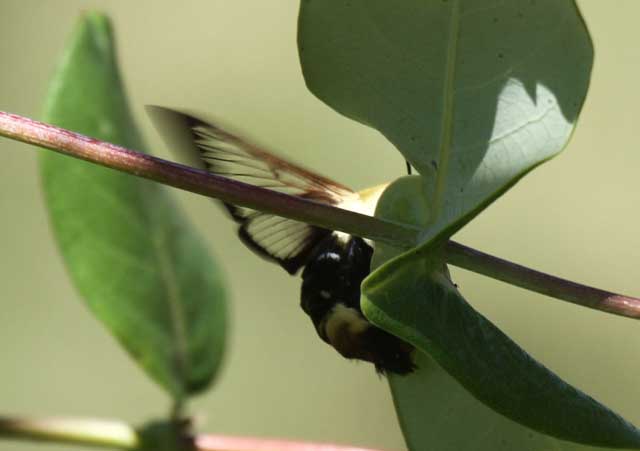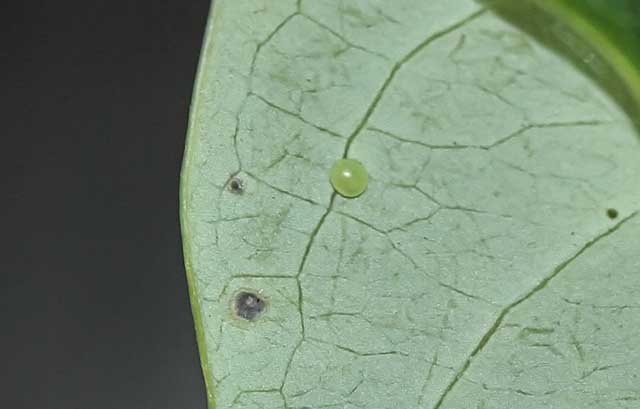Hemaris diffinis
hee-MAGH-rihsmDIF-fih-nihs
(Boisduval, 1836) Macroglossa diffinis
Snowberry Clearwing or Bumblebee Moth

Hemaris diffinis, Killeen, Bell County, Texas,
ovipositing on Coral Honeysuckle, (Lonicera sempervirens),
around 3:20pm, May 4, 2011, courtesy of Eric Runfeldt.

Hemaris diffinis egg, Killeen, Bell County, Texas,
green egg on Coral Honeysuckle, (Lonicera sempervirens),
May 4, 2011, courtesy of Eric Runfeldt.

Mischocyttarus phthicus, hunting? , Killeen, Bell County, Texas,
on Coral Honeysuckle, (Lonicera sempervirens),
May 4, 2011, courtesy of Eric Runfeldt.
I am not one hundred percent sure of my identification of this female. Eric sent it as Hemaris thysbe, and he may be correct.
Because of the black body, however, and absence of a definitive inward projection from the forewing marginal area, I think it is more likely
Hemaris diffinis.
Both species would fly in Eric's area, and both species use honeysuckle as a larval host, although thysbe more often uses Viburnum species.
Subsequently Eric indicated that more extensive observation led him toward a determination of Hemaris diffinis as well.
Many wasps and other predatory insects feed on caterpillars. The barely visible Mischocyttarus phthisicus on the upper side of the "egg leaf" is already
"casting its shadow".
This site has been created by Bill Oehlke.
Comments, suggestions and/or additional information are welcomed by Bill.
TAXONOMY:
Family: Sphingidae, Latreille, 1802
Subfamily: Macroglossinae, Harris, 1839
Tribe: Dilophonotini, Burmeister, 1878
Genus: Hemaris (Dalman, 1816) ...........
Species: diffinis (Boisduval, 1836)
|
Enjoy some of nature's wonderments, giant silk moth cocoons.
These cocoons are for sale winter and fall. Beautiful Saturniidae moths will emerge the following spring and summer.
Read Actias luna rearing article. Additional online help available.
Use your browser "Back" button to return to the previous page.
This page is brought to you by
Bill Oehlke and the
WLSS. Pages are on space rented from Bizland. If you would like
to become a "Patron of the Sphingidae Site", contact Bill.
Please send sightings/images to Bill. I will do my best to respond to requests for identification help.
 | 
Show appreciation for this site by clicking on flashing butterfly to the left.
The link will take you to a page with links to many insect sites. |




